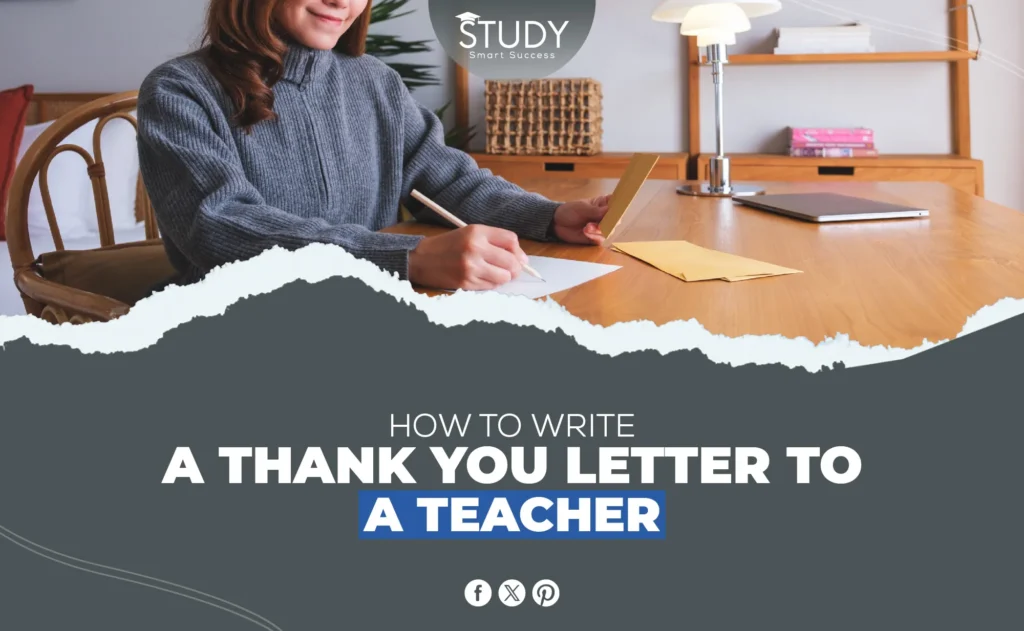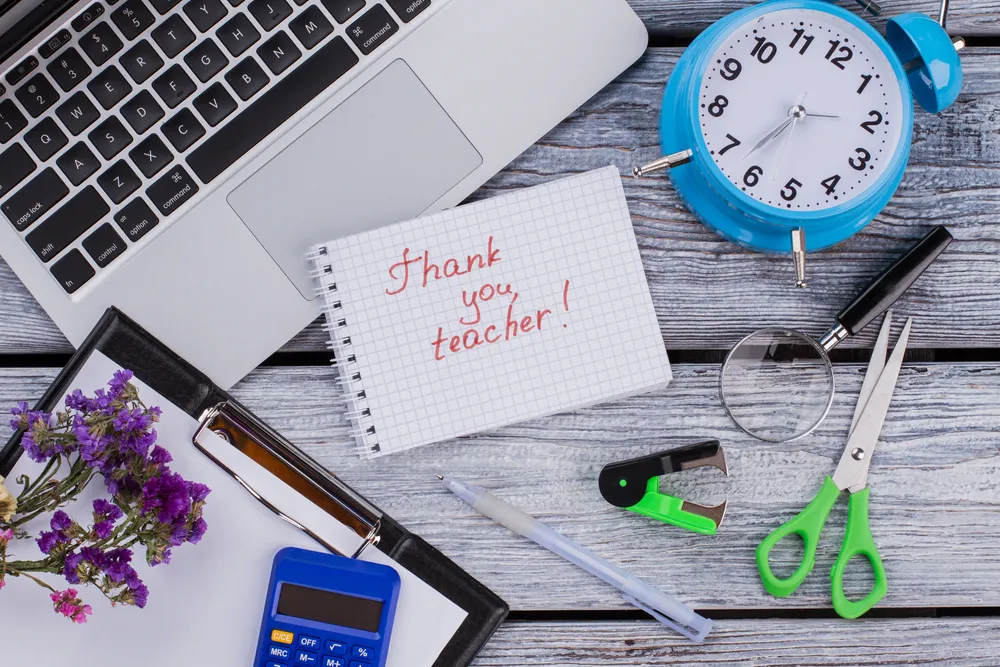Teachers are frequently overlooked heroes. They regularly affect teens outside school. People shape their personalities and sometimes plan their lives. An excellent thank-you message to a teacher shows thanks for their positive impact. This blog post will help you write a touching teacher thank-you message. This approach can help you write the perfect “thank you” message, whether you’re a student remembering advice, a parent grateful for school funding, or a teacher inspired by support and friendship.
If you’re a student and you’re stressed about your debate competition, suppose your teacher gives you the task of writing an argumentative essay for your debate competition, and you have only one question: How to Write an introduction for an Argumentative Essay?
Here’s how to say thank you in words and why it’s important to do so.
Why Writing a Thank You Letter Matters
Giving thanks is a deep thing to do. Emails and texts are used for quick messaging these days, but a note written by hand still has a unique value. It shows that you care about the person you’re sending it to, and ink on paper has a permanence and sincerity that digital pixels can’t match.
A note like this adds a rare and touching touch of warmth to the work of a teacher who works with many children every day. Something to remember, something to boost morale, and a small nod to the human link that is at the heart of learning.
Crafting Your Thank You Letter
Before you start writing your thank-you letter, you might want to make sure you have a clear head and a sincere heart. Think about the events or lessons that have changed you in a big way. It could be a certain way of teaching, a word of support during a tough time, or a lesson that went beyond schoolwork and covered life skills. These details will give your note more meaning.
Personalization Is Key
Start by saying hello to the person. It shows respect and attention to detail when addressing your teacher by their chosen title and name.
Be Specific
In the letter’s body, be clear about what you want to thank them for. This could be their hard work, the extra time they spent with you or your child, or the way their lessons changed you. Giving specific examples will help people understand and remember your letter better.
Express Sincerity
Your tone should come from the heart. Writing a thank-you card is a way to show true appreciation, not because you have to. If you had any problems that the teacher helped you solve, be sure to mention them. Being honest can make the letter seem more genuine.
Closing Your Letter
In the end, make a statement that looks ahead, maybe saying how you plan to use what you’ve learned in your future work. Say something nice at the end, like “With gratitude” or “Warmest thanks,” and then write your name.
The Importance of Presentation
Letter content is more important, but appearance is too. A handwritten note on decent paper is more personal than email or text. If you have poor handwriting, write slowly and clearly. Your letter’s careful composition and presentation will demonstrate your gratitude.
Due to the prevalence of digital communication, a handwritten thank you letter to a teacher is a thoughtful gesture. As essential as your words are your thoughts and work. This letter can be a valued reminder of how much a teacher influences students’ lives, now or later.
The Art of Grateful Prose
Setting the Tone
Introduce yourself and create the tone in the opening few words of your letter. Start with “Dear [Teacher’s Name]” for simplicity, politeness, and personalization. The purpose of using a teacher’s title is to recognize their professional expertise and experience, which would not have been achievable without their personal touch.
Express Specific Appreciation
Be precise about your gratitude in the letter. Did a lesson inspire you to learn more? Encouragement or kindness that made you feel better? Explain why these occurrences made you feel better and stood out. Practical examples and personal tales assist teachers in grasping their lessons.
Reflecting on Growth
As you continue your note, think about how the teacher’s guidance has helped you grow as a person or do better in school. This part is where you can talk about how their help has changed your outlook, given you more confidence, or helped you get through tough times. Sharing these ideas with teachers gives them a taste of how their hard work and commitment will affect people in the future.
Keep It Personal
The most effective thank-you letters show that the writer cares about the recipient. Tell them about what’s been going on in your life, your goals, or how their advice has helped you succeed. As good agents, teachers enjoy putting together the background of a “case” that has been solved—in this case, the case of a student who is motivated and doing well in school.
Looking to the Future
Take a look ahead at the end of the letter. Thank them for their impact, which you can be sure will last. This kind of thanks tells the teacher that you value the time and effort they put into you and that you know their effect will last.
Fine-tuning Your Thank You Letter
Language and Style
The words you use are important. A truthful, polite, and casual style is what you should aim for. Stay away from clichés and words that are too official. They can make your message less personal. You’re not just writing a thank-you note; you’re also making a letter that shows how you really feel about your guide.
Proofreading and Presentation
There should be no mistakes in your writing. Carefully check for mistakes. It can be disappointing to receive a thank-you letter that is full of spelling and grammar mistakes. It’s also important to look good, so if you can, use high-quality paper and be proud of your job.
Making It Special
Keep in mind that your thank-you letter should be unique. A modest gift, painting, or image from a great event or accomplishment can make it more precious. These presents remind people of their time together and what they learned. Make sure it matches the situation and adds value to your message without detracting from your gratitude.
Delivery with a Personal Touch
Consider how to deliver your thank-you letter last. Sending your letter via mail is wonderful, but handing it to your teacher in person is more sincere. The interaction can become a cherished memory, increasing your connection and thankfulness.
Writing a thank-you letter to a teacher is a longstanding custom that shows appreciation for their hard work and life-changing influence. It honors the teacher-student relationship in a basic but significant way. These guidelines will help you write a letter that symbolizes how education, mentoring, and personal connection have altered your life.
Choosing the Right Moment to Deliver Your Thank You Letter
When you send your thank-you letter, it can have a big effect on how it is received. An important time might be at the end of the school year, after a big accomplishment, or on a holiday like Teacher Appreciation Day. These times can add an extra layer of meaning to your act, making it even more remembered by the teacher.
Beyond the Letter: Other Ways to Show Gratitude
A thank-you letter is a strong way to show respect, but other actions can also work well with it. You could send your letter along with a small gift that shows you know something about the teacher’s hobbies or wants. If you’d rather, a public thank-you, like a shout-out in a school meeting or a social media post, can also spread the word and show how much they mean to more people.
The Ripple Effect of Saying Thank You
Think about how your thank-you letter can help your town develop an attitude of thanks. By talking about how you wrote and delivered a thank-you note, you can inspire your friends to think about and thank the people who have made their lives better. This chain effect of thanks can bring people together and bring attention to the important job that teachers do all over the world.
Keep it Focused
The letter should be short, but not too short. Keep your attention on the teacher and how thankful you are. Thank-you letters are one of the only times it’s okay to be repetitive—it helps the reader understand what the letter is for.
The Ripple Effect of Gratitude
Thank-you letters don’t just show thanks between the person who receives them and the person who writes them; they have a way of spreading. It gives off a good vibe that makes people appreciate each other and creates an atmosphere of recognition. In a society that values building understanding and character, this is a small but meaningful way to help.
The Legacy in Letters
Once written, a thank-you letter is a keepsake that can be looked at and kept, maybe along with the awards and teaching tools that teachers keep for a lifetime. A teacher may read your letter again years from now and be proud of how it changed their life. That’s what letters are all about: they’re a way to share thanks and knowledge that will last forever.
A Note That Echoes Through Time
In conclusion, a letter of thanks to a teacher is not only a gesture of appreciation; rather, it is a proclamation of the high regard in which we hold our educators. It serves as a barometer of worth from the past and a guarantee of resonance in the future. An affirmation of the relevance of education and the power of a determined educator is a note that reverberates through the annals of time till the end of time.
Our sincere wish is that you, the reader, would be motivated to show gratitude to those who have provided you with instruction and direction for your life. Your words have the power to express the profound resonance of your thanks and to spark a culture in which the act of teaching is treated with the respect and admiration that it merits.
I wish you the best of luck with your writing, and remind yourself that the pen is actually more powerful than the sword—not because it can fight, but because it can touch and change people’s lives. For all that you do, I am grateful to you, instructors.



